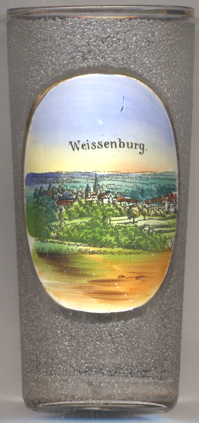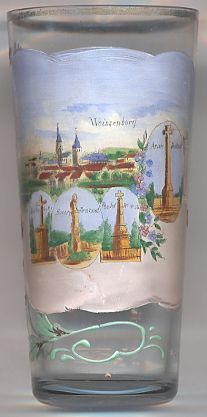

|
| FRANCE | FRANCE |
| région: Grand Est | |
| département: 67, Bas-Rhin |
 Wissembourg is situated at an elevation of 160 m on the little River Lauter close to the border between France and
Germany, in the extreme north-east of the région Grand Est, approximately 60 km north of
Strasbourg. Until 2014 Wissembourg ws a sous-préfecture of the Bas-Rhin département.
Since 2015 it belongs to the arrondissement Haguenau-Wissembourg (sous-préfecture at
Haguenau).
The name
Wissembourg is the Francosized version of the German name Weißenburg, meaning "white castle".
The municipality has a population of about 8,200 (1999).
Wissembourg is situated at an elevation of 160 m on the little River Lauter close to the border between France and
Germany, in the extreme north-east of the région Grand Est, approximately 60 km north of
Strasbourg. Until 2014 Wissembourg ws a sous-préfecture of the Bas-Rhin département.
Since 2015 it belongs to the arrondissement Haguenau-Wissembourg (sous-préfecture at
Haguenau).
The name
Wissembourg is the Francosized version of the German name Weißenburg, meaning "white castle".
The municipality has a population of about 8,200 (1999).
 The Benedictine abbey around which the town has grown was founded in the 7th century, perhaps under the patronage of
Dagobert I, king of Austrasia, king of all the Franks, and king of Neustria and Burgundy. The abbey was supported by
vast territories. The town was fortified in the 13th century. In 1354 king Charles IV made it one of the grouping of
ten towns called the Decapolis (Colmar, Haguenau / Hagenau,
Kaysersberg, Landau in der Pfalz (since 1521), Mulhouse / Mülhausen (until 1515),
Munster / Münster im Elsass, Obernai / Oberehnheim, Rosheim, Sélestat / Schlettstadt,
Turckheim / Türkheim, Wissembourg / Weißenburg). that survived annexation by France
under Louis XIV in 1678 and that was extinguished with the French Revolution. In 1677 a great fire destroyed many
houses and the Hôtel de Ville; its replacement dates from 1741–1752. Many early structures were spared: the
Maison du Sel (1448), under its Alsatian pitched roof was the first hospital of the town. There are many 15th and
16th-century half-timbered houses, and parts of the walls and gateways of the town. The Maison de Stanislas was the retreat
of Stanisłas Leszczyński, ex-king of Poland, from 1719 to 1725, when the formal request arrived, April 3, 1725
asking for the hand of his daughter in marriage to Louis XV.
The Benedictine abbey around which the town has grown was founded in the 7th century, perhaps under the patronage of
Dagobert I, king of Austrasia, king of all the Franks, and king of Neustria and Burgundy. The abbey was supported by
vast territories. The town was fortified in the 13th century. In 1354 king Charles IV made it one of the grouping of
ten towns called the Decapolis (Colmar, Haguenau / Hagenau,
Kaysersberg, Landau in der Pfalz (since 1521), Mulhouse / Mülhausen (until 1515),
Munster / Münster im Elsass, Obernai / Oberehnheim, Rosheim, Sélestat / Schlettstadt,
Turckheim / Türkheim, Wissembourg / Weißenburg). that survived annexation by France
under Louis XIV in 1678 and that was extinguished with the French Revolution. In 1677 a great fire destroyed many
houses and the Hôtel de Ville; its replacement dates from 1741–1752. Many early structures were spared: the
Maison du Sel (1448), under its Alsatian pitched roof was the first hospital of the town. There are many 15th and
16th-century half-timbered houses, and parts of the walls and gateways of the town. The Maison de Stanislas was the retreat
of Stanisłas Leszczyński, ex-king of Poland, from 1719 to 1725, when the formal request arrived, April 3, 1725
asking for the hand of his daughter in marriage to Louis XV.
The  abbey church of Saint-Pierre et Paul, was founded in the 7th century by Saint Pirmin on
an island in the river Lauter. The Romanesque church, of which the belltower still exists today, was built in the 11th
century. Most parts of the church date from the 13th century. A treasure of the church was the Christ de Wissembourg, the
world's oldest known figurative glass painting, which today is exhibited in the Musée de l'Œuvre Notre-Dame in
Strasbourg. The abbey was secularized in the French Revolution and despoiled of its treasures;
in 1803 it became the parish church, resulting in the largest parish church of Alsace, only exceeded in size by the
cathedral of Strasbourg. At the Abbey in the late 9th century, the monk Otfried composed a gospel harmony, the first
substantial work of verse in German.
abbey church of Saint-Pierre et Paul, was founded in the 7th century by Saint Pirmin on
an island in the river Lauter. The Romanesque church, of which the belltower still exists today, was built in the 11th
century. Most parts of the church date from the 13th century. A treasure of the church was the Christ de Wissembourg, the
world's oldest known figurative glass painting, which today is exhibited in the Musée de l'Œuvre Notre-Dame in
Strasbourg. The abbey was secularized in the French Revolution and despoiled of its treasures;
in 1803 it became the parish church, resulting in the largest parish church of Alsace, only exceeded in size by the
cathedral of Strasbourg. At the Abbey in the late 9th century, the monk Otfried composed a gospel harmony, the first
substantial work of verse in German.
The Battle of Wissembourg (1793) took place on 26 and 27 December, 1793 between the French revolutionary troops commanded by général Lazare Hoche and the Austrian and Prussian troops. The French vitory resulted in the acquisition of the Alsace region. The name of the battle (in the form Weissembourg) is inscribed among many others on the Arc de Triomphe in Paris.
The Battle of Wissembourg (1870) took place on August 4, 1870. It was the first battle of the Franco-Prussian War. 38,000
French soldiers faced 120,000 Germans. 10,000 soldiers died in battle. The French defeat allowed the Prussian army to move
into France. The Geisberg monument commemorates the event. The pictures on glass no. 2433 show several of the
monuments erected in memory of the various battalions:
The  monument of the Royal Infantry Regiment Nr. 1 (7?)
(Königliches Grenadierregment Nr. 1 (7?)),
monument of the Royal Infantry Regiment Nr. 1 (7?)
(Königliches Grenadierregment Nr. 1 (7?)),
The  monument for the Bavarian Corps
(Bayern-Denkmal),
monument for the Bavarian Corps
(Bayern-Denkmal),
The  monument for the Posen Infantry Regiment Nr. 53 (56?)
(Posisches Infanterieregiment Nr. 53 (56?)),
monument for the Posen Infantry Regiment Nr. 53 (56?)
(Posisches Infanterieregiment Nr. 53 (56?)),
The  Army monument
(Armee-Denkmal)
Army monument
(Armee-Denkmal)
The monuments have survived even the two World Wars.
[Texts adapted from http://en.wikipedia.org/wiki/Wissembourg]
![[scale]](lineal.jpg)